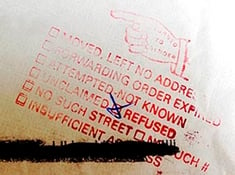 The most tangible evidence of addressing errors in any mailing that leaves your company is the volume of return mail. Instead of treating return mail as a nuisance, managers should consider it another tool to improve their address list.
The most tangible evidence of addressing errors in any mailing that leaves your company is the volume of return mail. Instead of treating return mail as a nuisance, managers should consider it another tool to improve their address list.
If a company has done a good job with cleaning their addresses, then their return mail will be below 1%. However, if that company mails out 50,000 bills a day, that still means 500 envelopes will be returned each day. Over 10,000 pieces will be returned in a month. That’s a lot of mail.
So, what should a company do? We recommend a multi-step approach:
- Keep accurate measurements
- Update moves first
- Fix obvious errors
- Use CASS, NCOALink and AEC for tougher problems
- Turn off mail for repeat offenders
- Repeat
Measurements are important to determine the effectiveness and efficiency of your address quality program. With return mail, you need to know more than just volumes. You also need to know what percentage of your outbound mail does the return mail represent. Studies have shown that almost 2.5% of presorted, First-Class Mail is undeliverable as addressed. However, best-in-class operations achieve a 1% or lower percentage of return mail. Accurate, consistent metrics will demonstrate where your operations stands, and how corrective actions are improving the situation.
Immediate attention should be given to pieces that have address update information attached. These are the easiest mistakes to fix. If a new address is provided, then the customer’s record should be modified. If the intended recipient has moved and left no address, then the customer should be contacted by alternate means (e.g., phone or email) to obtain the correct information.
The next target should be the returns with clearly marked errors – missing house number, no unit or apartment designated, incorrect ZIP code, etc. The customers’ records should be searched for the correct information and then the address updated. If the information isn’t evident, then contact your customer via phone or email.
Unfortunately, many of the Nixie codes provided on the yellow return labels are useless. The most common being “Undeliverable as Addressed”, with no additional information. These addresses should be processed through CASS and NCOALink software to identify possible reasons. These addresses may have already been processed through CASS before, but the errors were skipped over. With a smaller batch, more attention can be given to the errors. For the pieces that still can’t be resolved, consider using the USPS Address Element Correction (AEC) program.
If the address can’t be fixed, and mailpieces keep being returned, then your company should consider not mailing to those customers. There are very complicated rules that vary by industry about when a company can turn off mail. However, in most cases, sending a notification by Certified Mail, and then retaining the returned mailpiece will meet the official obligations. Work with your legal department to identify the best policy for your company.
People will continue to move without notifying you or the USPS. Errors will be made when entering customers’ addresses. Return mail will always exist. So every day, the process must be repeated. Each time with increasingly smaller numbers.
Physical mail remains a critical link to customers in an increasingly digital world. But mailpieces that are returned to your company add no value to the relationship. Take the next steps to reduce your return mail today.

